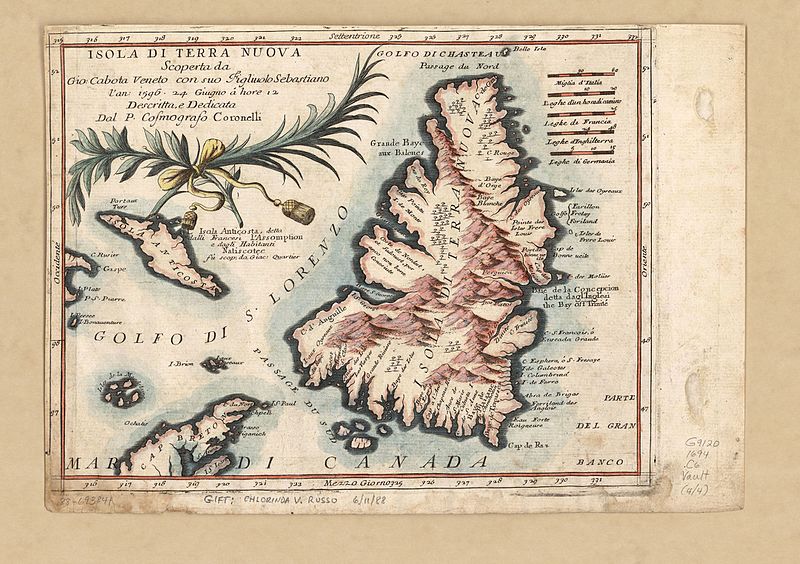John Cabot’s return to Bristol in 1497 elicited a tremendous interest in further exploring the North Atlantic and its great cod fisheries. Henry VIII granted patents to at least five other groups from 1501 – 1504 to explore the West. Little is known about most of these missions, except that Francis Fernandez and Joao Gonzales participated in many of them working with Bristol merchants. These two adventurers may have been the first to abduct Beothuk and bring them back to Europe as trophies.
In 1500 and 1501, Gaspar Corte-Real and his brother Miguel, members of the Portuguese royal household, sailed to Greenland, Labrador, and possibly Newfoundland. In 1501 Gaspar made another voyage to the Canadian Atlantic with three caravels and explored the east coast of Labrador. Two of Gaspar’s three ships returned to Lisbon in October 1501 but the third, with the leader of the expedition, did not return.
Gaspar’s brother Michael set out on 10 May 1502 to search for him with three vessels. When the group reached Newfoundland in June, it was decided that each vessel would explore a different part of the coast and meet up on 20 August at St. Johns. As the boats searched, all had multiple friendly trade opportunities with the Beothuk. One of the vessels explored the area beyond Placentia Bay where Gaspar was lost and found a boat of his but no survivors. As planned on 20 August, they returned to the agreed rendezvous point at St. Johns and found one of the other boats, but Michael’s ship was now missing. After waiting in vain for some time these two returned home alone.
In 1508, Thomas Aubert, a navigator from Dieppe was given command of La Pensée for a fishing and reconnoitering voyage in the New World in the service of the prominent shipowner Jean Ango (Lanctot, 2003). Little detail exists of this voyage, but it is known that he brought back the first Beothuk seen in France. Their costumes, arms, and canoes caused great excitement in Rouen, where they were baptized with great pomp.
In 1520 a Portuguese nobleman, Joao Alvares Fagundes, explored the southern coast of Newfoundland and may have reached as far as the mouth of the St. Lawrence River and the Nova Scotia coast. He received a captaincy to the lands which he had found from King Manuel of Portugal and established the first European colony in North America on Cape Breton at today’s Ingonish in 1521.
Few details are known of this settlement, except that it was established by Fagundes and several families, mostly from the Azores. They set up a fishing community, but after a year to 18 months, the local Beothuk turned hostile and began cutting their fishing lines, destroying their homes, and ultimately killing them all. The Beothuk already had a history of abuse from the Europeans and probably when they realized the colonists had come to stay, rather than visit to fish and trade, decided they must go.
In 1523, Estêvão Gomes (aka Esteban Gómez) of Portugal convinced Emperor Charles V to fund another expedition to find the Northwest Passage. Gomes had sailed with Magellan as a pilot of the San Antonio in the first circumnavigation of the earth, but at the Strait of Magellan in May 1521, he deserted and returned to Spain. He and several other deserters were put in prison but were released in September 1522 when the remainder of Magellan’s crew reached Spain and told of their harrowing experiences.
A 50-ton caravel, La Anunciada, was built for Gomes expedition and it sailed on September 24, 1524, from A Coruña, with a crew of 29 men. He likely first landed in Cuba and then headed north. There is no written account of his journey, so his itinerary is largely unknown. He may have gone north as far as the Cabot Strait and Cape Breton, and likely entered the upper reaches of New York Bay and the Hudson River. Along the way he passed along the coast of Maine, where he thought for sure that the estuary of the Penobscot River was the Northwest Passage. He returned to Spain on August 21, 1525, after abducting more than 50 Beothuk to sell as slaves. This would have been 5 – 10% of the whole Beothuk population in Newfoundland.
In 1527, John Rut from Essex was chosen by Henry VIII to make an expedition to North America in search of the Northwest Passage. Rut set sail from Plymouth with two ships Sampson and Mary Guilford. As they crossed the Atlantic Ocean, the Sampson was lost in a storm and the Mary Guilford met heavy ice, but it managed to reach the Labrador coast near St. Lewis Inlet and then set sail for St. John’s Harbor. Remarkably, at St. John, they came upon eleven Norman, one Breton, and two Portuguese fishing boats. Rut then proceeded southward to Puerto Rico, then Santo Domingo, and after being fired upon by a Spanish fort, headed home.
Illustration: Map of Newfoundland. Vincenzo Coronelli (1650-1718)
Bibliography:
Biggar, H.P. (1911) The precursors of Jacques Cartier 1497-1534: A collection of documents relating to the early history of the Dominion of Canada. Ottawa Government Printing Bureau.
De Costa, B.F. (1884) Chapter VI. Norumbega and its English explorers. In: Winsor, J. (ed.), Narrative and critical history of America. Vol.3. Houghton, Mifflin and Co. Boston
Hiller, J. K. (2004) The Portuguese Explorers. In: Heritage Newfoundland and Labrador. https://www.heritage.nf.ca/articles/exploration/portuguese.php
Lanctot, G. (2003) Aubert, Thomas.In: Dictionary of Canadian Biography,Vol. 1, University of Toronto/Université Laval, http://www.biographi.ca/en/bio/aubert_thomas_1E.html.
Vigneras, L.A. (2003) Corte-real, Gaspar,” Dictionary of Canadian Biography, Vol. 1, University of Toronto/Université Laval, http://www.biographi.ca/en/bio/corte_real_gaspar_1E.html
